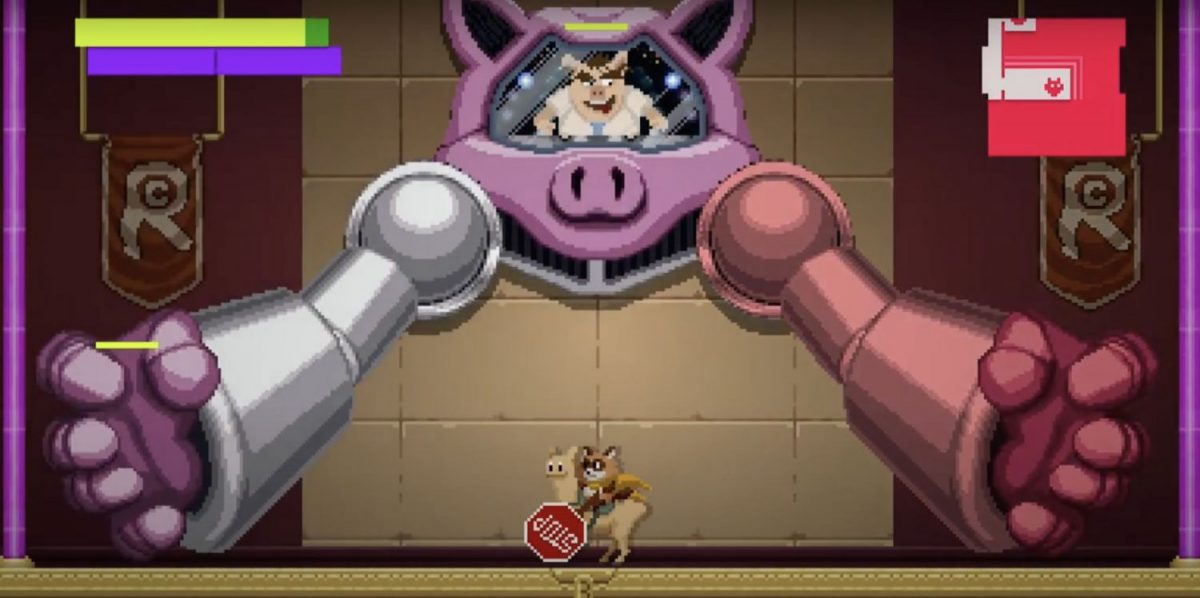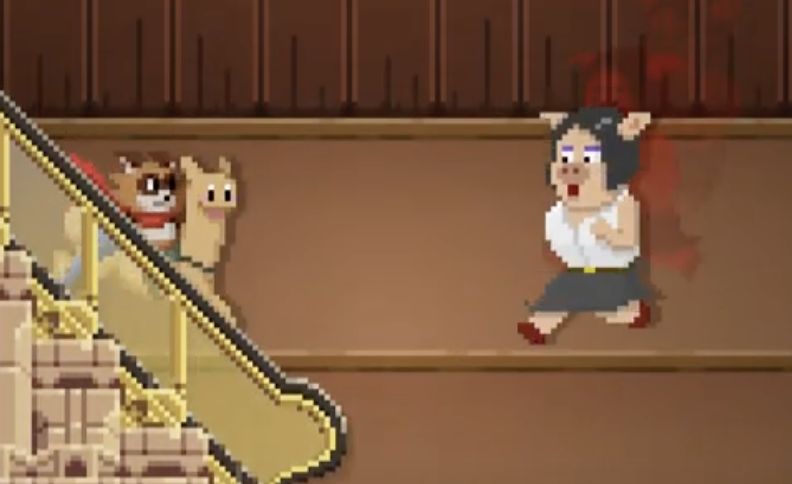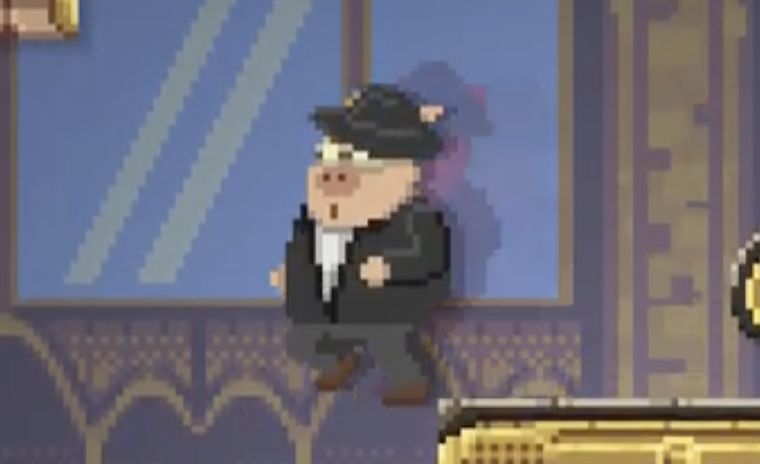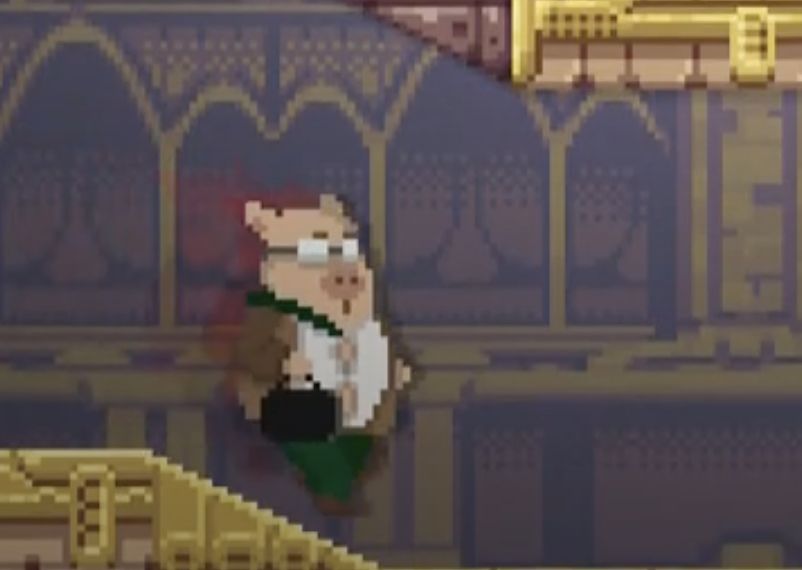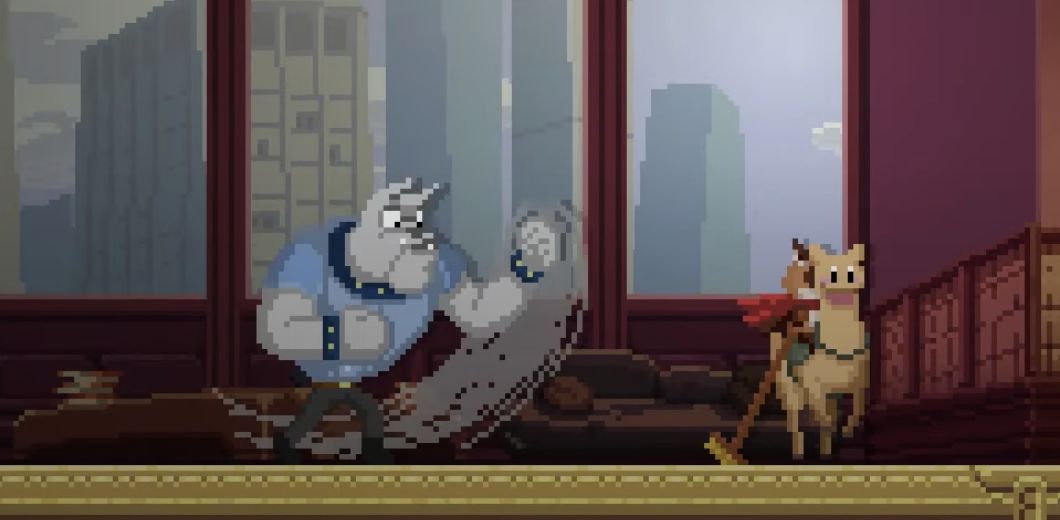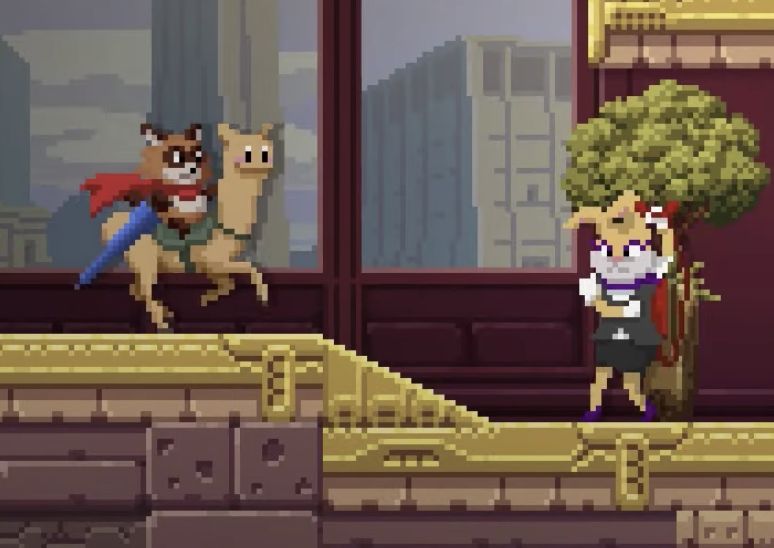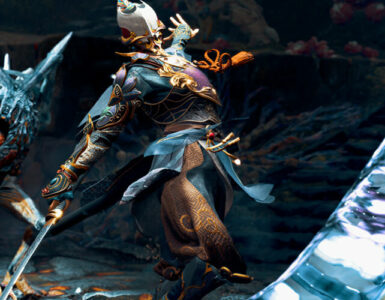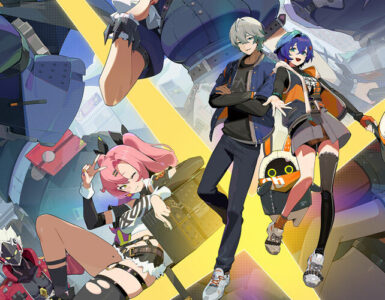Starring a cute raccoon named TanTan and his llama, this super epic game is about an unlikely superhero duo who attempts to free an Orwellian society from the tyranny of the evil game developer, Regnantcorp. The premise is simple, even silly, but SuperEpic: The Entertainment War is a game many NES and retro game fans will surely come to cherish.
The first thing we noticed about the Nindie game is the cute pixel-art and soundtracks that are reminiscent of the classic games (even the haunting music from Castlevania). While many would immediately think of games from half a decade ago when they hear of pixel-art, the style has been actually seeing a revival in the recent years.
SuperEpic proves that the squares are still trendy with their retro art style, reminiscent of 80s and 90s games. The game itself contains popping bright colours over chunky 2D graphics. The first part has an overall warm tone, consisting of polished gold platforms lined with cedar brown bricks underneath, while later chapters featured similar visuals but with more variant colours.
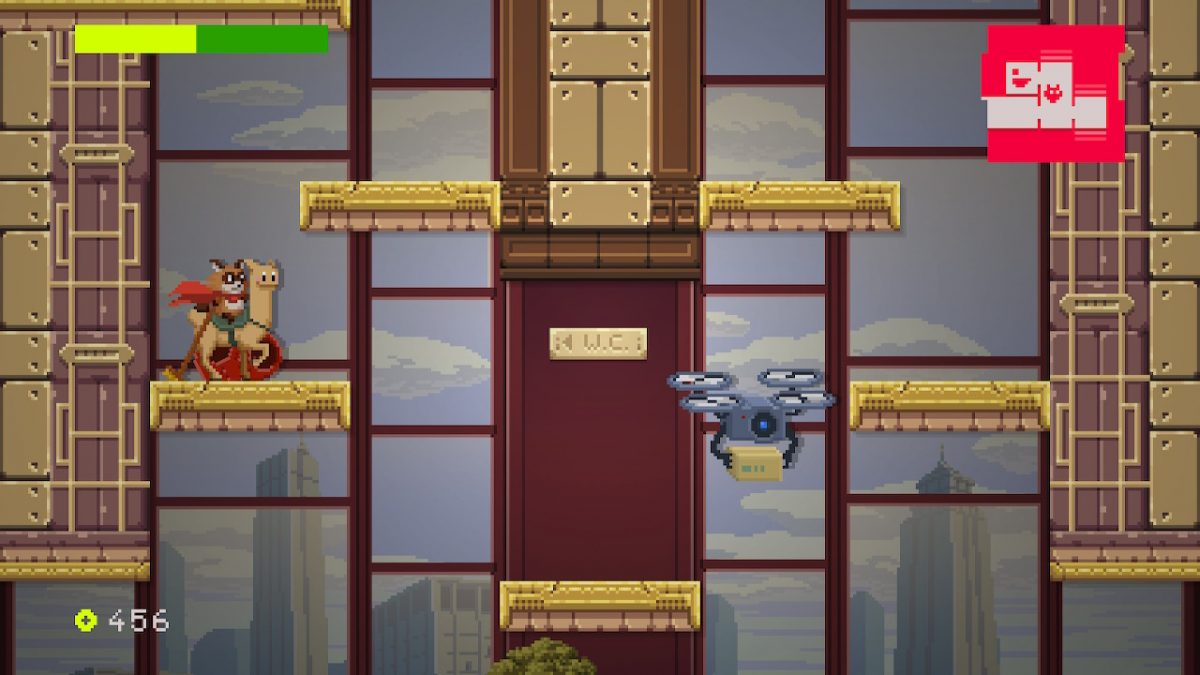
We love the story of the game as it is a satirical take on the video game industry with an anti-monetization storyline. It uses tongue-in-cheek humour to give critical commentary on big corporations who cash in through mediocre games via microtransactions. The best part are the enemies, who consist of literal Corporate Pigs who monetise off the inhabitants of this world by brainwashing them into being addicted to these supposedly free-to-play games.
The game even parodies many old classics such as The Legend of Kage and Ghosts ‘n Goblins through either its gameplay, maddeningly random enemy placement or environmental settings. The save (bath)rooms are reminiscent of those in Castlevania while later levels pay homage to Mega Man and Metroid. Even the cutscenes felt similar to many nostalgic NES games.
The 16/32 bit era cartoon sprites inspired characters look great too. We have the corporate pigs running around in neat office blouses, A-line skirts, cute bowler hats and more. The entire place is an animal farm, with creatures ranging from alligators, monkeys, hens, rats and bats. Every one of them had unique outfits and the characters were so cute, we felt bad beating them up…well almost.
The characters themselves are also a parody of other cartoon characters. There is a telephone swinging bunny who looks like Lola Bunny from Looney Toons. Otherwise, note the angry bulldog guard who closely resembles Spike from Tom & Jerry. There’s even a vampire boss, who’s a real money sucker, in one of the levels who goes into theatrics by smashing his wine glass. The Senior Monetization Vampire is possibly a nod again to Castlevania.
Cute designs aside, the game is hard. True to its Metroidvania style gameplay, you will be spending hours smacking through endlessly increasing enemies on various levels and backtracking old paths to find new openings. The map itself is maze-like with many secret openings, but the fights and instructions are pretty straightforward though saving your progress is another challenge altogether.
Bathroom breaks are the real life-saver in this megacorporation, where you will be able to save game progress and refill your energy bar. However, dying is still a punishing element as players can be revived only once by the system at the cost of half their in-game coins. Beyond that, you will have to restart from your last save point, and those being few and sparsely spaced out means having the high potential of losing big game progress.

The difficulty spikes after the halfway point with enemies who can block your attacks and longer corridors with increasing numbers of foes. The game sort of becomes roguelike, with procedurally generated levels and death becoming more permanent as you are flung back to the beginning instead of simply reviving at your last toilet stop.
A downside is that enemy attack patterns can get repetitive and the backgrounds of the various chapters could do with more variants or hints because it can get confusing when we are constantly backtracking. Also for the more adventurous explorer, do note that leaving and reentering a room will cause all previously defeated enemies to respawn.
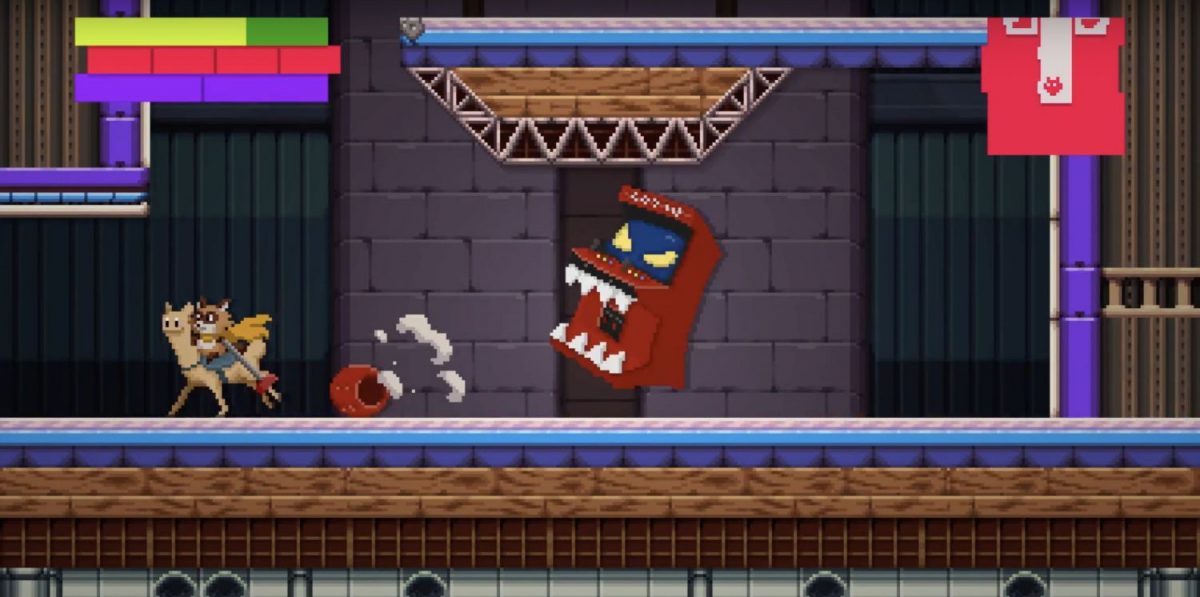
With all these enemies, you will definitely need to depend on the upgrades along the way to keep your moves fresh and stay at the top of the game. Weapon upgrades can be obtained through Migjorn the blacksmith who you will meet every now and then. And true to its parody on micro-purchases, skill and weapon upgrades follow a free-to-play-esque system that has you paying for them using the coins instead of earning the upgrades.
TanTan has three main fighting moves players can pull off – an uppercut using a broom, a smack-down using a plunger and even a swipe-cut with grandma’s umbrella! Stringing them together in a combo to beat down enemies is incredibly satisfying.

Some new skills we bought along the way consisted of a double jump, a dash and a rage meter. We even got to purchase new weapons like a “Stop” sign. It’s incredibly fun to strategize using these moves. You can double-jump and smackdown drones in order to beat them into the ground or even smack tougher enemies into the air to immobilise them and finish them off there.
As with the enemies, being limited three attack patterns can cause the game to become repetitive. The enemies themselves also rarely break out of their aimless walking routine and they even fall off the ledges. Hence, earning coins can be as easy and dull as positioning yourself at the edge of the ledge and taking the enemies out like pigs to the slaughter. But with a variety of strategies that you can come up with by yourself, things should more or less be kept fresh throughout.

Another neat surprise is the minigames weaved into the plot. The minigames created a metanarrative that could be activated when players scan a QR code with their mobile phones. How this works is that in order to get some loot, you have to get past laser barriers which can only be deactivated by a keypad. However, the keypad’s code can only be obtained after we scan the in-game QR code and beat the mobile mini-game.
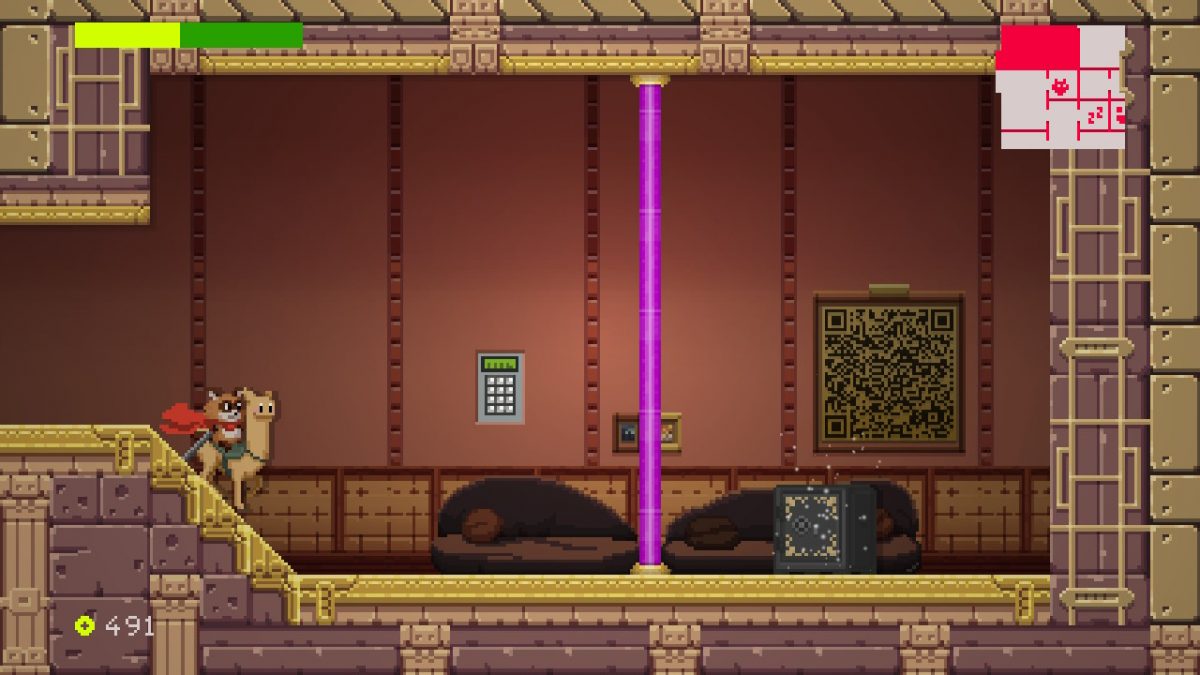
The minigames themselves weaved into the monetisation narrative as the games were parodies of free-play games like Flappy Bird, bubble shooters, Frogger, and more. Though this was a very original idea, we sometimes felt that it was a hassle as it hindered gameplay.
Another thing the game could have improved on is the dialogue. While most dialogues are witty, some came off as overtly caricatural and hence awkward. One example would be the Senior Regnantcorp Evangelist who was a caricature of toxic bosses who shut down questions. The dry dialogue made the game sometimes feel like it was taking itself too seriously, which was jarring to the overall humorous parody they were aiming for.
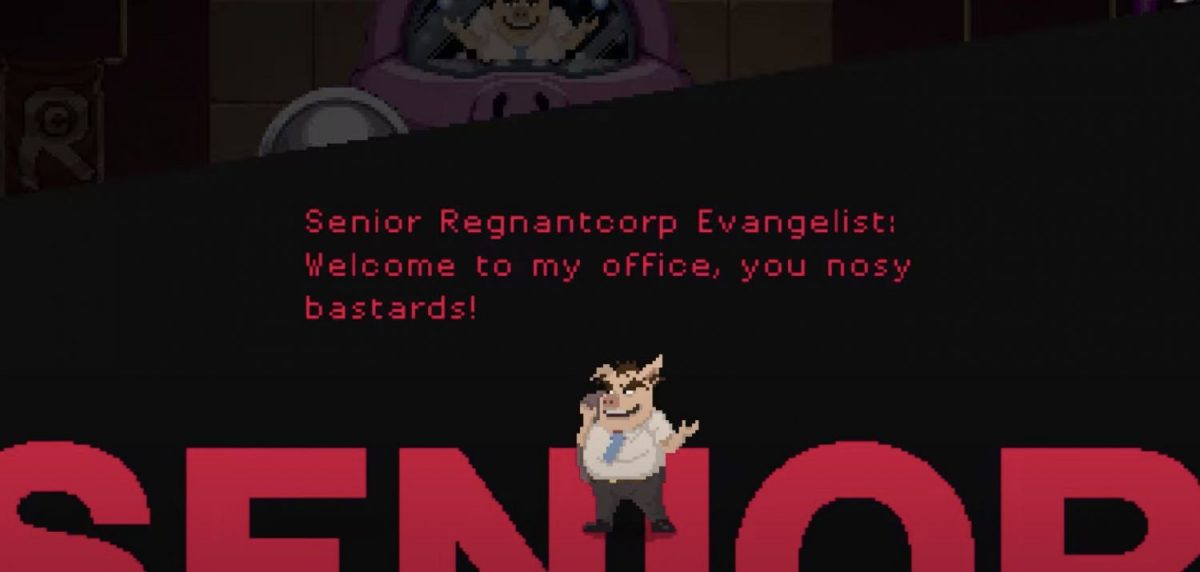
We did, however, enjoy the critique of the capitalist mentality. This was done via Slave Team Builder who spoke about how they provide rewards to the workers so that they stay working in this office. We really loved how the idea paralleled some real-world situations whereby workers are turned into mindless creatures who don’t realise that they have sold their soul to the company.

All in all, SuperEpic: The Entertainment War is a super cute and entertaining game with critical yet humorous commentary about the greedy game developers and big corporations. NES and modern gen players will definitely appreciate the pixel style art and the witty fourth wall humour of the game.
GEEK REVIEW SCORE
Summary
SuperEpic: The Entertainment War is a cute retro-esque game which will give you an addictively satisfying time whacking the enemies. Accompanied by naggingly catchy computer music the game is humorous tongue-in-cheek critique on the video game industry.
Overall
7.9/10-
Gameplay - 8.5/10
8.5/10
-
Story - 7.5/10
7.5/10
-
Presentation - 7.5/10
7.5/10
-
Value - 8/10
8/10
-
Geek Satisfaction - 8/10
8/10


